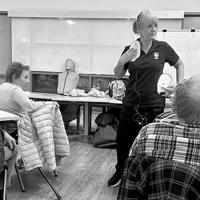An annual tradition, the Heart Health program at the Solon Senior Center in February –reminds Solon seniors of the importance of taking care of their hearts, and not just in the romantic area
For the twenty or so members of the Solon Senior Center who attended the February 4 program, February was definitely heart health month.
Firefighter/Paramedic Michelle Marva provided a program on CPR, AEDs and overall heart health to the interested attendees. She said that as the heart muscle ages, it can become less flexible and less strong at pumping blood through the body, and if that is combined with arteries that are hardened or narrowed, this can lead to cardiac disease.
But she said, there are ways to keep one’s heart beating strong, even into advanced age.
“You can help your heart, by being active, eating a healthy diet, and keeping down your stress level,” said the firefighter/paramedic. “And by getting checked out by your doctor if you are not feeling right.”
She added, however, that there were some things attendees could not control.
“When we find someone who is not feeling well, perhaps short of breath, or having pain, and they are older, we might ask a lot of questions. One of those questions will be, “do you have a history of heart disease in your family?”
She explained that if someone has a family member who has died from a heart attack before the age of 65, some “alarm bells go off.”
She said heredity, especially a fatal heart attack at an early age for a family member, is a risk factor for heart disease.
Diabetes, however, is the number one risk factor for having a cardiac event, she said, adding that diabetics need to take extra special care of their hearts.
Firefighter Marva said that another way to support heart health is to help someone else’s heart– by knowing CPR.
“Although this is not a certification course, I am going to show you the basics of CPR,” she shared.
She utilized a CPR manikin to show how one might help a person in distress.
“Number one, you want to talk, ask the person if they are ok?,” she explained. “If they are unresponsive, you need to move to step two.”
She said if there was someone nearby, you should be the one to take control of the situation, and to ask that person to call 911.
“Then you need to do what you are able to do. If you can’t move the person, ask for help in moving them to the floor. If you can’t do the chest compressions, instruct someone else on how to do them.”
She traveled around the room with the manikin to show attendees how to put one hand over the other, and then how to push down, for a depth of about two inches, to do a chest compression. She reminded attendees to do the compressions at a rate of about 100 to 120 beats per minute. Firefighter Marva said that “chest compressions are the most important thing to concentrate on when someone is unconscious or not breathing,” she shared.
When asked by one of the attendees how to know if someone was having a stroke, and might need other kinds of help, Firefighter Marva said to start chest compressions, because without them, the person’s body cannot do anything else.
“You have to get blood moving, which gets oxygen to the lungs,” she shared.
Next, she reminded attendees of what an AED (Automated external defibrillator) is for, “it’s not to restart the heart, what it does is stop the fluttering of the heart, it shocks it into normal rhythm.”
She asked patrons where the AED was located in the Solon Community Center, and most attendees did not know exactly where it was.
“It is down the hall on your right, there is a sign above it. It’s very important for everyone here to know the location of the AED, and now you can definitely take that knowledge away from this class,” she shared.
Firefighter Marva then did a quick demonstration of how the AED uses a computerized analysis system and AI voice to instruct the user on what to do– how to connect the AED’s pads to a person and then when to stand back.
“The AED does an analysis if the person has a rhythm or not, so it will not let you shock someone who has a heartbeat. Do not worry, the machine will tell you what to do,” she shared.
At the end of the program, Firefighter Marva invited attendees to try out the CPR manikin. She also instructed them on how to use infant manikins to practice helping a baby who was choking.
“We do this every year, and every year Firefighter Michelle Marva comes to us to make sure we are well-informed about our heart health,” said Kathy McQuaide, senior center program coordinator. “We will continue to provide a similar program each February in recognition of Heart Health Month, and to remind us all of its importance.”

